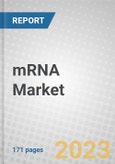Report Scope
This report focuses on the mRNA therapeutics market. This reports include the types of mRNA and their application in therapy. Also, the report focuses on the patent analysis and clinical trial analysis of mRNA. The report also portrays the trends and dynamics affecting the market during the study period. The study covers market projections through 2028 and profiles major market players.By geography, the market is segregated into North America, Europe, Asia-Pacific and the Rest of the World (RoW). The market is estimated through 2028.
The publisher also summarizes the main industry acquisitions and strategic alliances from January 2020 through December 2022 and identifies the trends in this activity.
Report Includes
- 37 data tables and 27 additional tables
- An overview of the global market related to mRNA therapeutics
- In-depth analysis of global market trends, featuring historical revenue data for 2021 and 2022, estimated figures for 2023, forecasts for 2028, and projections of compound annual growth rates (CAGRs) through 2028
- Evaluation of the current market and revenue growth prospects specific to mRNA therapeutics, accompanied by a market share analysis by therapeutic type and geographical region
- Coverage of the pandemic threats, therapeutic developments, and new technologies in the market
- Discussion of the advantages of mRNA over protein
- and DNA-based delivery systems, demographic and economic trends, and outlook for the mRNA therapeutics market
- Information on prophylactic vaccines, vaccine discovery and development, and R&D activities
- Analysis of the various therapeutics as well as promising vaccines intended for the prevention and treatment of chronic and infectious diseases
- Assessment of regulatory structure, pricing and reimbursement scenarios, the pipeline for new molecules and therapeutics
- Market share analysis of the key companies and mergers & acquisitions, joint ventures, collaborations, and partnerships
- Profiles of leading market participants
Table of Contents
Chapter 1 Introduction
Chapter 2 Summary and Highlights
Chapter 3 Market Overview
Chapter 4 Market Dynamics
Chapter 5 Target Disease and Disorders
Chapter 6 Pipeline and Clinical Trial Analysis
Chapter 7 Market Breakdown by Product
Chapter 8 Market Breakdown by Region
Chapter 9 Emerging Technologies and Developments
Chapter 10 Patent Analysis
Chapter 13 Company Profiles
List of Tables
List of Figures
Samples

LOADING...
Executive Summary
The global market for mRNA therapeutics reached $60 billion in 2022 and is estimated to reach $21 billion by the end of 2028. It is expected to decline at the CAGR of -8.6% during the forecast period. The decline, which stems from the end of COVID-19 pandemic, should be mitigated by the introduction of new drugs during the forecast period.The COVID-19 pandemic created a niche market for mRNA therapeutics, particularly vaccines. Developed countries used mRNA vaccines for protection against the severe acute respiratory syndrome (SARS)-CoV-2. The fast-paced development of mRNA vaccines was possible due to advancement in sequencing as well as two decades of previous research on mRNA drugs. mRNA drugs should become a major segment of vaccines and therapeutics.
The mechanism of action of mRNA vaccine is like that elucidated by the protein-based vaccines. The mRNA particle, which is inserted into a healthy patient, carries the code for an antigen (a small piece of protein found on the virus’s outer membrane). Viral proteins are produced via the mRNA code. The body recognizes it as a foreign material and produces antibodies necessary for the protection against the diseases.
Key factors driving the mRNA global market include the increasing number of pandemics and epidemic diseases. In the past 20 years, the world has experienced the two epidemics: severe acute respiratory syndrome (SARS) and Middle East respiratory syndrome (MERS); and the pandemic COVID-19. These situations highlighted the need for technologies like mRNA that are easy to produce and upscale quickly. The COVID-19 pandemic pushed mRNA therapeutics to the forefront of the pharma and bio-pharma industries.
Another key growth factor is the pharmaceutical industry’s investment in the mRNA segment. Large pharmaceutical companies are seeking innovative drugs that have limited side effects. mRNA presents one such opportunity. Also, private investments are increasing in this segment, driven by the COVID-19 pandemic.
However, the market also is facing a few challenges, such as lack of standard regulations that affect a different class of therapeutics. This leads to confusion for new and existing players for which pathway to follow. Existing and new technologies, such as protein and CRISP, respectively, also pose competition.
The pipeline of mRNA drugs is robust. Under favorable conditions, a drug should enter the market by late 2024 or early 2025. Currently, the majority of drugs in the pipeline target infectious diseases or are being developed as vaccines. Also, therapeutic drugs target cancer treatment. Some drugs have received fast-track status from the FDA, increasing the pace of those clinical trials due to their promising results. Drug trials using mRNA vaccines are showing efficacy in the range of 70% to 85%. There are 2 influenzas vaccines which are, under phase 3 clinical trials and will be commercialized during the forecast period.
Companies Mentioned
- Biontech Se
- Merck Kgaa
- Moderna Inc.
- Nutcracker Therapeutics
- Strand Therapeutics








